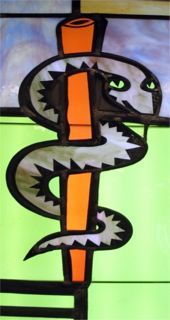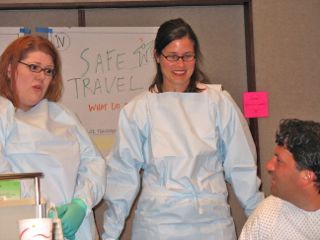Liberating Healthcare
To date, Liberating Structures initiatives in healthcare include; preventing the spread of superbugs in the US and Canada; reducing errors in chronic safety challenges (e.g.,medication reconciliation and patient falls); shifting hospital culture from a tradition of top-down only to more self-organization; starting-up a complexity-science inspired research consortium; creating scenarios for strategy-making in an unpredictable market; connecting innovators across the US and the UK; and, launching a variety of transformational leadership initiatives in nursing and medical schools. We have experienced dramatic results in all these settings.
Our experience applying Liberating Structures to healthcare barely scratches the surface of what is possible.
Efforts in one area often spill over into other settings. Work with preventing superbugs spread out of hospitals to nursing homes, home health, and schools. LS practitioners take what they learn into the rest of their life. For example, liberating microstructures learned on a hospital unit have been re-purposed for teaching newly minted nurses, doctors, and therapists.
Additionally, Liberating Structures applied to one project can be immediately used in another. Molly Angel in the Providence Health System first worked on MRSA prevention in Montana then started to apply Liberating Structures to other clinical challenges (e.g., delirium in the ICU) across the system.
Whenever including and unleashing more people makes a difference, Liberating Structures can generate spectacular performance quickly. Liberating Structures transform routine meetings as well as help people find a way through massively tangled challenges.
Looking forward, we believe that Liberating Structures can be helpful in re-shaping clinical rounds, reducing hospital re-admissions, improving access to A nurse, therapist and doctor using improv to prototype safe infection prevention practices (Billings Clinic, Montana) care, and a host of other challenges. Solving problems and creating fertile ground for innovation is seriously fun when using Liberating Structures.
A nurse, therapist and doctor using improv to prototype safe infection prevention practices (Billings Clinic, Montana) care, and a host of other challenges. Solving problems and creating fertile ground for innovation is seriously fun when using Liberating Structures.
Check out how Liberating Structures are being used to spark the transformation of nursing.
The following articles and stories illustrate how Liberating Structures are helping to transform healthcare organizations.
Front Line Ownership Brenda Zimmerman et al.
Inventing the Future of Healthcare Chris McCarthy
Academic Leadership from the Inside Out Dr. Diane Magrane
Superbug Prevention Plus Enduring Cultural Change (Dr. Michael Gardam)
Marisa's Rehearsal for Real Life As A Nurse (Sherry Belanger)
Saving Lives By Changing Relationships, Dr. Arvind Singhal, Prucia Buscell and Keith McCandless
Safely Taking Risks: Complexity and Patient Safety Keith McCandless
Oil, Water, Apples, Oranges: Bootstrapping Innovation with Social Networks Linda DeWolf, Keith McCandless
Mastering the Art of Innovating: A Funny, Wonderful Thing Happened on the Way to My Deliverable! Linda DeWolf, Keith McCandless
Transforming Discoveries: Partners on the Journey Keith McCandless, Linda DeWolf
Surprise & Serendipity At Work: Managing the Unknowable Future Jim Smith, Keith McCandless
The Doctor Weighs In blog (a two part story) Liberating Structures for Enduring Cultural Change: A Disruptive Innovation Keith McCandless
NEW: Here is an abstract regarding success with fall prevention in Billings Montana.
Use of the Liberating Structures in Fall Reduction: Out of the Box Strategies
Fall reduction is a universal goal for hospitals across the U.S. Multiple factors contribute to falls; therefore, a multifaceted approach is required. The fall rate on a 35 bed step down unit at Billings Clinic, a Magnet hospital, was consistently above the National Database for Nursing Quality Indicators (NDNQI).
Patients who experience a fall while hospitalized can suffer adverse outcomes directly related to the fall. Falls can result in an increased length of stay, head injury or fractures.
The unit used Liberating Structures, which are innovative and interactive efforts that make it possible for people and organizations to create novel methods to improve quality such as fall prevention. Staff were required to attend a one hour interactive competency session in a patient room on the unit. A combination of CNAs and RNs were assigned to each session. Session discussion began with general identification of patients at risk for falling. This was followed by an improv and TRIZ, two liberating structures where participants re-arranged the patient room and common equipment to facilitate or directly cause a patient fall. Staff were asked to create a space that could achieve the worst possible outcome for patient falls. These “reverse” exercises stimulated dialogue and discussion around problem solving. During the session, participants were asked to self-reflect on falls they had witnessed or identified as trends and communicate what could have been done to prevent them.
Following the use of the Liberating Structures, the unit appreciated a greater than 50% reduction in falls over a 12 month period. This unit is now consistently below NDNQI benchmark for step down units.
Through the use of Liberating Structures and innovative educational practices individual units as well as organizations can realize a decrease in patient falls and an increase in patient safety.
- Laurie L. Smith, MSN, RN, Manager, ATU-Billings Clinic lsmith@billingsclinic.org
